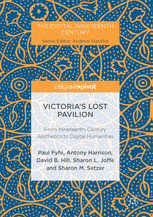The Book
 To accompany and expand on the materials presented on the web, the project team has co-authored a book, Victoria's Lost Pavilion: From Nineteenth-Century Aesthetics to Digital Humanities (Palgrave Macmillan, 2017), the first title of a new "Digital Nineteenth-Century" series edited by Andrew Stauffer. To get an idea of its contents, chapters and abstracts are listed below:
To accompany and expand on the materials presented on the web, the project team has co-authored a book, Victoria's Lost Pavilion: From Nineteenth-Century Aesthetics to Digital Humanities (Palgrave Macmillan, 2017), the first title of a new "Digital Nineteenth-Century" series edited by Andrew Stauffer. To get an idea of its contents, chapters and abstracts are listed below:
Introduction: Experiments from 19th-Century Aesthetics to Digital Humanities (Paul Fyfe). The introduction quickly surveys the history of Queen Victoria's garden pavilion as well as the contemporary project at North Carolina State University to renovate it in digital space. It provides an overview for each of the book's chapters, arguing for the significance of the pavilion across several historical and contemporary frameworks. Finally, it suggests how the project as a whole gets its very rationale from Victorian contexts, including nineteenth-century notions of virtuality and the legacy of historical architecture which the Victoria's Lost Pavilion project remediates.
Chapter 1: "The Little Hot-Bed of Fresco Painting": Queen Victoria's Garden Pavilion at Buckingham Palace (Sharon L. Joffe). In the early 1840s, Queen Victoria and Prince Albert authorized the construction of a small summer house in the gardens of Buckingham Palace. This chapter surveys how that pavilion became the unlikely location for an artistic "experiment" in which the medium of fresco painting became associated with British nationalism. It tracks Prince Albert's careful planning, his relationship with Ludwig Gruner as his adviser, and the thoroughgoing German influences which ironically defined the pavilion's aspirations to express British artistic talents and aesthetic identity. The chapter concludes by exploring Queen Victoria's own reactions to the project as well as the building's ultimate fate.
Chapter 2: Architectural Histories and Virtual Reconstructions: Queen Victoria's Lost Pavilion in Digital Space (David B. Hill). Modeling historical structures in virtual space poses many challenges, especially when the original physical structure no longer exists. This chapter reconstructs the pavilion's architectural history as an expression of its time and as part of a longer tradition of design experiments in which garden pavilions play an important role. The chapter then illustrates the research and digital processes used to reconstruct the building. The research team coupled historical documents—original sketches, engravings, color plates, and a lone black and white photo—with architectural modeling tools to achieve sufficiently accurate form, space, and material representations of the pavilion. Experienced through various forms of immersive and interactive media, the model becomes a critical element in portraying and understanding the pavilion's historical narrative.
Chapter 3: The Contested Status of the Garden Pavilion: "Perfect 'Bijou'" or Royal Blunder? (Sharon M. Setzer) Months before it was completed in the summer of 1845, the Garden Pavilion emerged as a site of narrative contest over the taste of Victoria and Albert, the capabilities of British artists, the efficacy of royal patronage, and the viability of the state-sponsored project to decorate the new Houses of Parliament with frescoes. Ranging from effusive praise to blistering criticism, responses recorded by Queen Victoria, Benjamin Robert Haydon, William M. Thackeray, Anna Jameson, and a number of anonymous authors writing for the periodical press constitute a dialogic reception history that re-presents the Garden Pavilion as a controversial hub of artistic activity. Considered as such, the small Pavilion not only provides grounds for rejecting monolithic models of "Victorian" aesthetics but also provokes new arguments about the Victorian arts.
Chapter 4: The Garden Pavilion: A Portal to Victorian Taste (Antony Harrison). Though a good deal of private discussion surrounding the decoration for the new Houses of Parliament focused on technical matters of painting, decisions about how to proceed largely hinged upon issues of aesthetic appropriateness and even taste. This chapter shows how such matters of "taste" encode political as well as aesthetic orientations to British figuration. It surveys exchanges of letters among Prince Albert and his circle as well as reviews focusing on taste, and argues that the deliberately eclectic artworks and furnishings designed for Victoria's garden pavilion were, in some respects, revolutionary for the time. Ultimately, the pavilion reveals the hybridization of Victorian taste, itself a discursive expression of conflicting political and aesthetic goals that only resolve in the practical encounters with Victorian buildings, art, and objects.
Chapter 5: Radiant Virtuality (Paul Fyfe). This chapter situates "Victoria's Lost Pavilion" amid related work in virtual modeling and their interpretive problematics. Drawing from a tradition in textual criticism, this chapter renovates Jerome McGann's notion of "radiant textuality" to extended virtual objects and built environments in digital space. It argues that projects like Victoria's Lost Pavilion must emphasize their work as interpretive models over their appeal as experiential time machines. These models should expose their sources and critical conjectures as much as they appeal to the historical imagination with immersive representational fidelity. What results is "radiant virtuality," linking innovative work in immersive environments to our scholarly legacy of curating and interpreting the cultural past.
